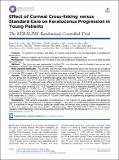Files in this item
Effect of corneal cross-linking versus standard care on keratoconus progression in young patients : the KERALINK randomized controlled trial
Item metadata
| dc.contributor.author | Keralink Trial Study Group | |
| dc.contributor.author | Larkin, Daniel F P | |
| dc.contributor.author | Chowdhury, Kashfia | |
| dc.contributor.author | Burr, Jennifer M | |
| dc.contributor.author | Raynor, Mathew | |
| dc.contributor.author | Edwards, Matthew | |
| dc.contributor.author | Tuft, Stephen J | |
| dc.contributor.author | Bunce, Catey | |
| dc.contributor.author | Caverly, Emilia | |
| dc.contributor.author | Doré, Caroline | |
| dc.date.accessioned | 2021-11-25T15:30:01Z | |
| dc.date.available | 2021-11-25T15:30:01Z | |
| dc.date.issued | 2021-11 | |
| dc.identifier | 274063018 | |
| dc.identifier | bdaec70e-44ff-462a-babb-e2aa922ae801 | |
| dc.identifier | 33892046 | |
| dc.identifier | 85106885613 | |
| dc.identifier | 000710479200018 | |
| dc.identifier.citation | Keralink Trial Study Group , Larkin , D F P , Chowdhury , K , Burr , J M , Raynor , M , Edwards , M , Tuft , S J , Bunce , C , Caverly , E & Doré , C 2021 , ' Effect of corneal cross-linking versus standard care on keratoconus progression in young patients : the KERALINK randomized controlled trial ' , Ophthalmology , vol. 128 , no. 11 , pp. 1516-1526 . https://doi.org/10.1016/j.ophtha.2021.04.019 | en |
| dc.identifier.issn | 0161-6420 | |
| dc.identifier.other | ORCID: /0000-0002-9478-738X/work/93514701 | |
| dc.identifier.uri | https://hdl.handle.net/10023/24399 | |
| dc.description | Supported by the National Institute for Health Research (NIHR ) Efficacy and Mechanism Evaluation Programme (grant no.: 14/23/18), a Medical Research Council and NIHR partnership. It was coordinated by University College London’s Comprehensive Clinical Trials Unit and sponsored by University College London. The trial otherwise was supported in part by the NIHR Moorfields Biomedical Research Centre and NIHR Moorfields Clinical Research Facility (grant no.: CRF-2016-10030). | en |
| dc.description.abstract | Purpose To examine the efficacy and safety of corneal cross-linking (CXL) for stabilization of progressive keratoconus.DesignObserver-masked, randomized, controlled, parallel-group superiority trial. Participants Sixty participants 10 to 16 years of age with progressive keratoconus, one eye of each deemed the study eye. Methods The study eye was randomized to either CXL plus standard care or standard care alone, with spectacle or contact lens correction as necessary for vision. Main Outcome Measures The primary outcome was steep keratometry (K2) in the study eye as a measure of the steepness of the cornea at 18 months. Secondary outcomes included keratoconus progression defined as a 1.5-diopter (D) increase in K2, visual acuity, keratoconus apex corneal thickness, and quality of life. Results Of 60 participants, 30 were randomized to CXL and standard care groups. Of these, 30 patients in the CXL group and 28 patients in the standard care group were analyzed. Mean K2 in the study eye 18 months after randomization was 49.7 D (standard deviation [SD], 3.8 D) in the CXL group and 53.4 D (SD, 5.8 D) in the standard care group. The adjusted mean difference in K2 in the study eye was –3.0 D (95% confidence interval [CI], –4.9 to –1.1 D; P = 0.002), favoring CXL. Adjusted differences between groups in uncorrected and corrected vision favored eyes receiving CXL: –0.31 logarithm of the minimum angle of resolution (logMAR; 95% CI, –0.50 to –0.11 logMAR; P = 0.002) and –0.51 logMAR (95% CI, –1.37 to 0.35 logMAR; P = 0.002). Keratoconus progression in the study eye occurred in 2 patients (7%) randomized to CXL compared with 12 patients (43%) randomized to standard care. The unadjusted odds ratio suggests that on average, patients in the CXL arm had 90% (odds ratio, 0.1; 95% CI, 0.02–0.48; P = 0.004) lower odds of experiencing progression compared with those receiving standard care. Conclusions CXL arrests progression of keratoconus in the majority of young patients. CXL should be considered as a first-line treatment in progressive disease. If the arrest of keratoconus progression induced by CXL is sustained in longer follow-up, particular benefit may be derived from avoiding a later requirement for contact lens wear or corneal transplantation. | |
| dc.format.extent | 11 | |
| dc.format.extent | 1352099 | |
| dc.language.iso | eng | |
| dc.relation.ispartof | Ophthalmology | en |
| dc.subject | Cornea | en |
| dc.subject | Cornea cross-linking | en |
| dc.subject | Keratoconus | en |
| dc.subject | RE Ophthalmology | en |
| dc.subject | RM Therapeutics. Pharmacology | en |
| dc.subject | 3rd-DAS | en |
| dc.subject.lcc | RE | en |
| dc.subject.lcc | RM | en |
| dc.title | Effect of corneal cross-linking versus standard care on keratoconus progression in young patients : the KERALINK randomized controlled trial | en |
| dc.type | Journal article | en |
| dc.contributor.institution | University of St Andrews. School of Medicine | en |
| dc.contributor.institution | University of St Andrews. Population and Behavioural Science Division | en |
| dc.identifier.doi | 10.1016/j.ophtha.2021.04.019 | |
| dc.description.status | Peer reviewed | en |
This item appears in the following Collection(s)
Items in the St Andrews Research Repository are protected by copyright, with all rights reserved, unless otherwise indicated.

